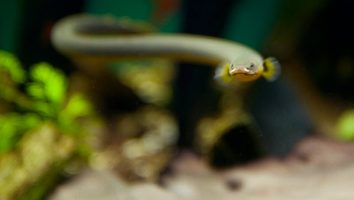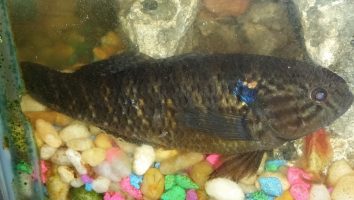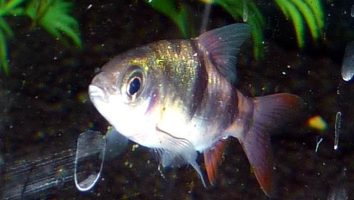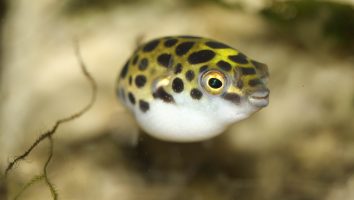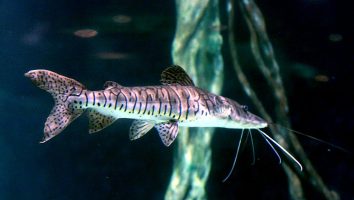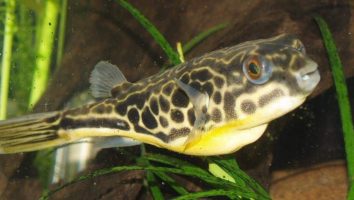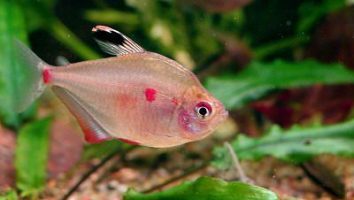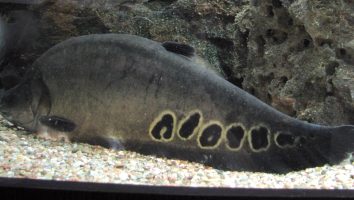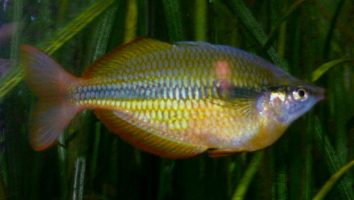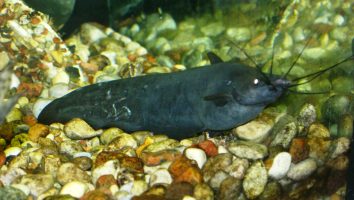The Cockatoo Dwarf Cichlid is a beautiful freshwater fish that’s perfect for beginners. They’re easy to care for, and they’re not too big, so they can be kept in a smaller tank.
But even though they’re easy to care for, there are still a few things you need to know to keep them happy and healthy.
In this guide, we’ll teach you everything you need to know about Cockatoo Dwarf Cichlid care. You’ll learn about their diet, tank mates, size, and more!
Table of contents
Species overview
Cockatoo dwarf cichlids (Apistogramma cacatuoides) are a freshwater fish that’s native to the Amazon Basin in South America.
They are found in a wide variety of habitats but prefer slow-moving waters with plenty of vegetation. This is something to keep in mind when setting up their tank as they’ll need some plants to feel comfortable.
Cockatoo dwarf cichlids are omnivores and will eat a wide variety of food. In the wild, they primarily eat small insects and crustaceans.
These cichlids are very popular in the aquarium scene due to their vibrant colors and relatively peaceful nature. They are also very easy to breed which is something that many aquarium hobbyists are looking for.
Appearance
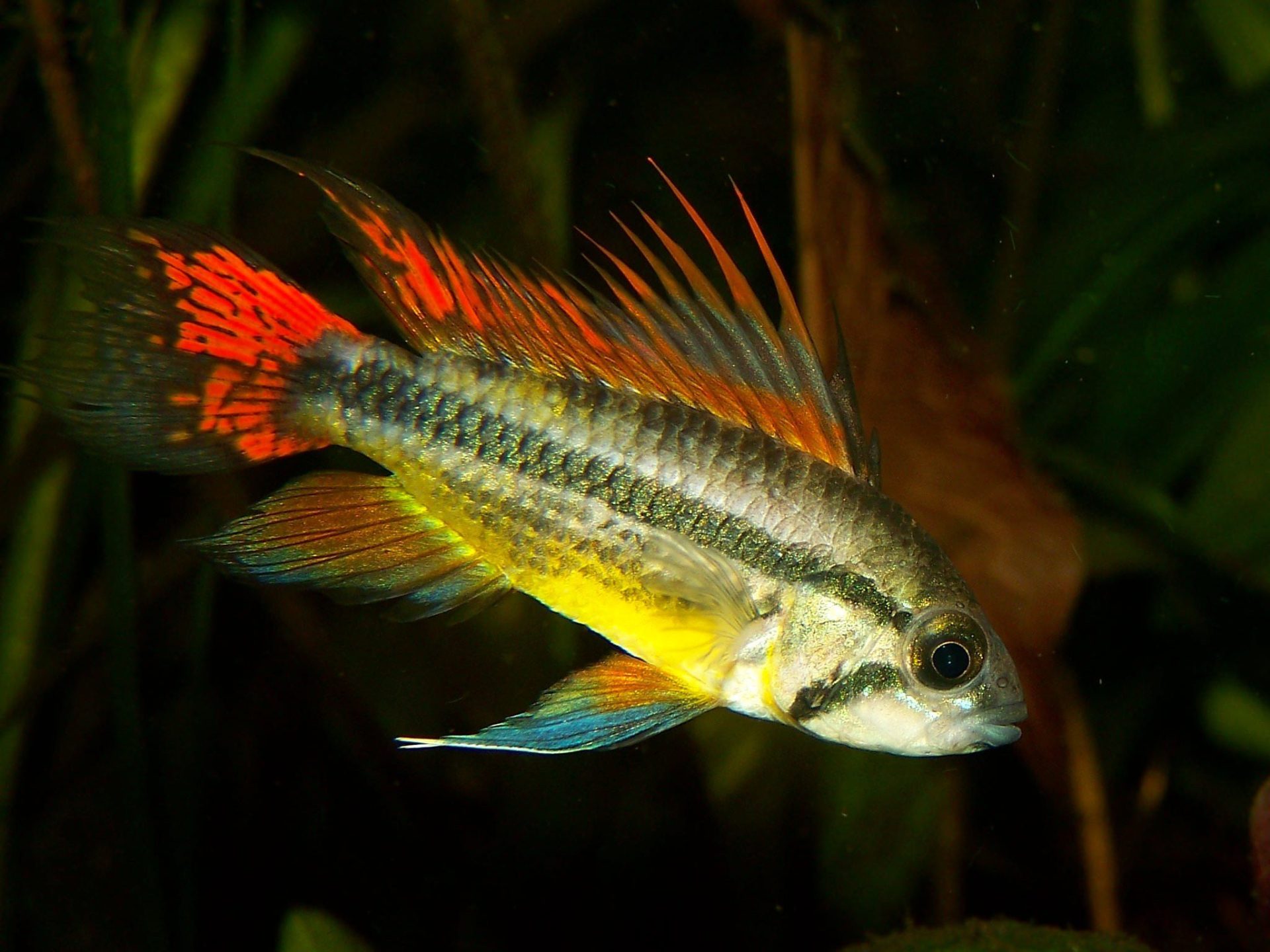
The first thing you’ll notice about the Cockatoo Dwarf Cichlid is the large dorsal fin that extends almost the entire length of their body.
This is easily the most prominent feature on this fish and it’s hard to miss.
The rest of the fish is a little more subdued in comparison. They have a long and thin body that’s a little bit laterally compressed.
Their pectoral and ventral fins are both quite small. The caudal fin is forked and fairly large in comparison to the rest of the fins.
This cichlid has a small head with large eyes. Their mouth is slightly upturned which is typical of most cichlids.
The Cockatoo Dwarf Cichlid is a very colorful fish. They have a light blue body with electric blue stripes running down their sides.
The dorsal fin is colored a deep red and the caudal fin has a yellow hue.
Lifespan
The average lifespan of a Cockatoo dwarf cichlid is around 5 to 7 years. There are a number of factors that impact their life expectancy.
For starters. if these fish haven’t reproduced then their lifespan will usually be on the higher side of this range. That process can really take a toll on the fish.
The general level of care they receive obviously matters a great deal as well. Even though these are very hardy fish, they’ll obviously live longer in optimal conditions.
Size
Cockatoo dwarf cichlids only grow to be about 2.5 inches in length.
Tank
Tank Size
The recommended tank size for Cockatoo dwarf cichlids is 30 gallons. This is the minimum size we would recommend but, if you can, go for a 40-gallon tank or larger.
The extra space will give you a lot more flexibility when it comes to stocking your tank and will give your fish the room they need to roam and explore.
Water Parameters
Cockatoo dwarf cichlids are a bit more sensitive to water quality than some other freshwater fish. They come from slow-moving rivers and streams in Africa. These habitats are typically well-oxygenated with soft to medium hardness.
To maintain a healthy cockatoo dwarf cichlid, it’s important to keep the following water parameters in check.
- Water temperature: 74 to 80 degrees Fahrenheit
- pH levels: 6.5 to 7.5
- Water hardness: 5 to 15 dGH
- Alkalinity Levels: 2-10 dKH
What To Put In Their Tank
The best thing you can do when setting up the inside of an aquarium for Cockatoo Dwarf Cichlids is to mimic their natural habitat as much as possible.
This doesn’t mean that you have to go out and find a bunch of rocks from the Amazon, but it does mean being mindful of the materials you use.
For the substrate, we recommend using a mix of sand and small rocks. This will give them plenty of places to hide and feel secure while also providing a surface that’s not too abrasive.
As for plants, you have a few different options. Java Fern, Hornwort, and Water Wisteria are all great choices that will do well in most tanks.
You should also include some driftwood in their habitat. This will give them something to hide behind and make them feel more secure. It’s also a great place for algae to grow, which they will snack on from time to time.
Finally, don’t forget to include a few caves or hiding spots. These fish like to have a place to retreat to when they feel threatened. Something as simple as a flower pot turned on its side can work perfectly.
Common Diseases
Cockatoo dwarf cichlids are a hearty bunch and don’t fall ill often. In fact, they’re one of the more disease-resistant freshwater fish out there.
However, that doesn’t mean that they can’t get sick. There are still a few things that you need to watch out for.
The most common illness that these fish experience is ich. This is a parasitic infection that will show itself as white spots on the body of your fish.
It’s important to catch ich early so it doesn’t have a chance to spread. The good news is that ich is relatively easy to treat, as long as you catch it early.
The other thing you need to be on the lookout for is hole-in-the-head disease. This is another disease that is more common in cichlids, but it can still affect Cockatoo dwarf cichlids from time to time.
This disease is caused by poor water quality and will present itself as pits or holes in the head of your fish. If you notice this, it’s important to act fast and improve the quality of the water in your tank.
Behavior & Temperament
The Cockatoo dwarf cichlid is a peaceful fish that does well in a community tank. Although it is a dwarf cichlid, it can still be quite aggressive towards other fish that resemble its own species. So, it’s best to keep only one Cockatoo dwarf cichlid per tank.
These fish are known to be shy, so they may hiding a lot. Provide them with plenty of hiding spots, and they will be out and about in no time. Cockatoo dwarf cichlids are also known to be fin nippers, so it’s best to keep them with fish that have thick fins.
When it comes to food, Cockatoo dwarf cichlids are not picky eaters. They will eat just about anything you give them.
Tank Mates
Cockatoo dwarf cichlids are generally peaceful fish. They’re not known for being aggressive and can get along with most tank mates.
However, there are a few things to keep in mind when adding these fish to your community tank.
First, cockatoo dwarf cichlids come from South America. This means that they prefer warm water. As a result, you’ll need to make sure that your tank is in the right temperature range for these fish.
Secondly, cockatoo dwarf cichlids are bottom dwellers. They prefer to stay close to the substrate and won’t venture up to the middle or top of the tank.
As a result, you’ll want to add tank mates that occupy different parts of the water column. This will help keep the entire tank occupied and reduce the chances of aggression.
Some good cockatoo dwarf cichlid tank mates include:
- Neon Tetras
- Guppies
- Platies
- Mollies
- Swordtails
- Corydoras Catfish
- Otocinclus Catfish
- Plecostomus
Breeding
Cockatoo dwarf cichlids are mouthbrooders, which means that the female will carry the eggs in her mouth until they hatch. This species is also known to be quite aggressive, so you’ll need to take some precautions when setting up your breeding tank.
First, you need to find a male and a female that are both healthy and of breeding age (around 2 years old). Then, you’ll need to set up a breeding tank.
The breeding tank should be at least 20 gallons and should have plenty of hiding places. You can use caves, rocks, and plants to create a network of hiding spots. This is important because the female will need a place to hide when she’s not carrying the eggs in her mouth.
The water conditions in the breeding tank are also important. The temperature should be between 75 and 80 degrees Fahrenheit. The pH should be around 7.5 and the water should be soft.
When you’re ready to start breeding, add the male and female to the tank. The male will start to chase the female around and may even nip at her. This is normal behavior.
Eventually, the female will lay a batch of eggs (usually between 20 and 30). The male will fertilize them and then the female will pick them up in her mouth.
At this point, you can remove the male from the tank. The female will take care of the eggs on her own.
After about 21 days, the eggs will hatch and the fry will be released into the tank. The fry will be very small, so you’ll need to feed them live food. Baby brine shrimp is a good option.
As the fry grow, you can start to add other foods to their diet. Once they’re big enough, you can add them to your main tank.
Conclusion
Cockatoo Dwarf Cichlid care can be a bit challenging but it’s definitely worth it in the end.
This is a beautiful fish that will add a lot of personality to your tank. They’re also relatively easy to care for once you learn about their specific needs.
If you’re looking for a new fish to add to your tank, we highly recommend the Cockatoo Dwarf Cichlid!

